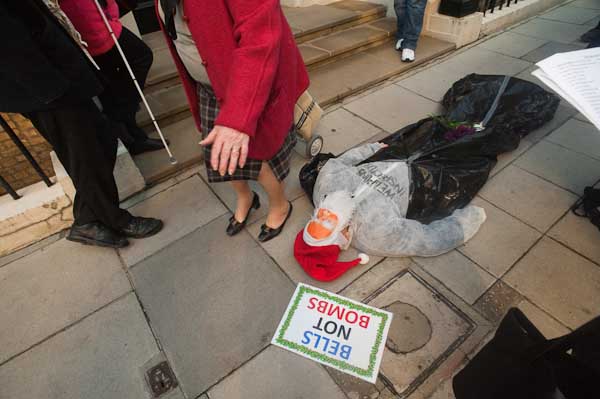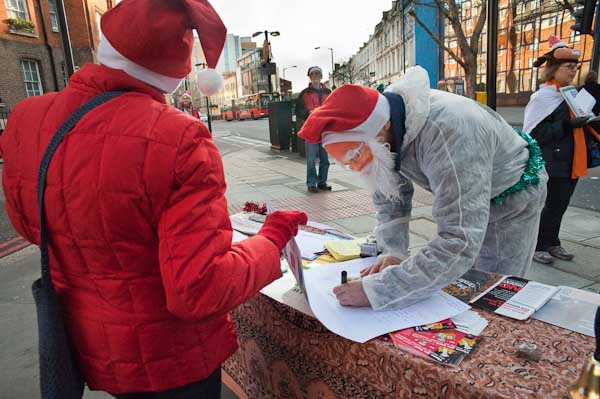I made life a little harder for myself on Thursday by forgetting to check my camera settings before taking pictures. No excuse, I just forgot.
Normally I have a roughly 35 minute train journey to London and often either a bus or an underground ride to the location when I’m photographing demonstrations, although quite are few that take place in Central London are in easy walking distance from the mainline station I arrive at.
When I get on the train I usually sit down and take out my camera and check everything is ok. If I’m not taking the train I do this at home before setting out. All the basic stuff like spare batteries for camera and flash, spare CF cards, cleaning cloth, lens cleaning kit live in my bag along with my camera and my normal set of lenses, so when as usual I find I’m in a rush and have to pick up my bag and run for the train I can be fairly sure I’ll have what I need.
On the train I usually check the lens surfaces and clean if necessary, get the camera to clean the sensor, format the CF card in the camera and restore the camera settings to my defaults. The Nikon lets you store sets of custom settings – and I almost always use the same set.
Then I’ll think about where I’m going and what I’ll be taking (so far as I know), the weather and anything else and decide what would be suitable initial settings for the job. I decide on the appropriate ISO and whether or not to use auto-ISO and if so, on the highest setting, and make appropriate settings for the aperture and shutter speed for aperture priority,m shutter priority and manual modes so that should I switch to them from P (either accidentally or on purpose) I don’t have too much fiddling to do or get exposure horribly wrong. I make sure I haven’t left the metering on spot – which I use at times, but if you use it when you think you are in centr-weighted mode can be embarrasing. And a few other little things like that, so that when I arrive somewhere if things are already happening I can just pick up the camera and start taking pictures.
Because I know if things are happening, that’s what I will do, and if the camera isn’t set up sensibly it may well be some time before I notice. I’m not very good at noticing the information in the viewfinder, rather single-minded about looking at the picture and solving the visual problems. I do occasionally glance at the image on the back of the camera, but ‘chimping’ disturbs the flow, and in any case quite a few problems don’t show up obviously there.
I’ve also got the problem that I can’t actually see the display on the camera back at all clearly (or the top plate display) when I’m working. I need glasses to read, but have never used to wearing them when using a camera. My Nikons have just enough eyesight correction available so I can see the viewfinder image clearly (though its rather blurred for most other people if I ask them to take a picture with it.) One day I’ll have to have an expensive talk with my optician and start working with glasses on, but I don’t look forward to it.
On Thursday I was distracted and forgot my usual routine, missing one very important point when I took out the camera. I’d left the ISO at 3200 from when I’d been taking pictures in a very dimly lit pub a couple of days earlier.
Of course I should have noticed the ISO and rather unusual settings for me such as 1/500 fll displayed very clearly below the image in the viewfinder, but I actually managed to shoot several hundred images without doing so!
Fortunately, the D700 does a pretty marvellous job at ISO3200 (if it didn’t I would have noticed earlier as I do occasionally zoom right into images on the screen and put my glasses on to check, particularly that eyes are sharp in portraits.) So back in Lightroom, with just a touch more noise reduction and sharpening than normal I had more or less perfect results.
3200 is just a little extreme, and viewed at actual size on screen I could see just a little more noise and a little less detail than normal, but an actual size image would be 31 inches (79cm) wide if my screen was that wide.

But looking on the positive side, I think this image wouldn’t have worked so well at the ISO 400 I would probably have been working at had I got my act together.
And perhaps the extra depth of field does help in a picture like this:

so perhaps I ought to work at ISO 3200 more often. Although it might make sense to edit the EXIF data before trying to smuggle it past Alamy quality control.
The event was a demonstration by Trident Ploughshares at the UK HQ of the leading company involved in making nuclear bombs in Britain, at the AWE at Aldermaston. Of course Lockheed Martin is a US company, and there are allegations that it is also producing warheads for US use at their Aldermaston bomb factory, probably in breach of international war.
Given the Cold War ended 20 years ago and we are supposed to support an international treaty aimed at stopping the proliferation of nuclear weapons, we might ask why we are paying a US company billions of pounds to make more. Any government that is serious about making savings and repaying our huge national debt should be ditching our nuclear programme rather than expanding it.More pictures and more about it on My London Diary.